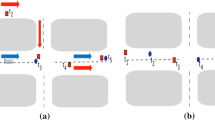Abstract
An interesting issue in moving object databases is to find similar trajectories of moving objects. Previous work on this topic focuses on movement patterns (trajectories with time dimension) of moving objects, rather than spatial shapes (trajectories without time dimension) of their trajectories. In this paper we propose a simple and effective way to compare spatial shapes of moving object trajectories. We introduce a new distance function based on “one way distance” (OWD). Algorithms for evaluating OWD in both continuous (piece wise linear) and discrete (grid representation) cases are developed. An index structure for OWD in grid representation, which guarantees no false dismissals, is also given to improve the efficiency of similarity search. Empirical studies show that OWD out-performs existent methods not only in precision, but also in efficiency. And the results of OWD in continuous case can be approximated by discrete case efficiently.
















Similar content being viewed by others
References
H. Alt, C. Knauer, and C. Wenk. “Matching polygonal curves with respect to the frechet distance,” in Proc. Int. Sym. on Theoretical Aspects of Computer Science, pp. 63–74, 2001.
S. Brakatsoulas, D. Pfoser, R. Salas, and C. Wenk. “On map-matching vehicle tracking data,” in Proc. Int. Conf. on Very Large Data Bases, pp. 853–864, 2005.
T. Brinkhoff. “Generating traffic data.” Bulletin of the Technical Committee on Data Engineering, IEEE Computer Society, Vol. 26(2):19–25, 2003.
K. Chan and W. Fu. “Efficient time series matching by wavelets,” in Proc. Int. Conf. on Data Engineering, pp. 126–133, 1999.
L. Chen and R. Ng. “On the marriage of lp-norms and edit distance,” in Proc. Int. Conf. on Very Large Data Bases, pp. 792–803, 2004.
L. Chen, M. T. Ozsu, and V. Oria. “Robust and fast similarity search for moving object trajectories,” in Proc. ACM SIGMOD Int. Conf. on Management of Data, pp. 491–502, 2005.
M. de Berg, M.V. Krevel, M. Overmars, and O. Schwarzkopf. Computational Geometry Algorithms and Applications. Springer, 2000.
C. Faloutsos, M. Ranganathan, and Y. Manolopoulos. “Fast subsequence matching in time-series databases,” in Proc. ACM SIGMOD Int. Conf. on Management of Data, pp. 419–429, 1994.
E. Keogh, K. Chakrabarti, M. Pazzani, and S. Mehrotra. “Locally adaptive dimensionality reduction for indexing large time series databases,” in Proc. ACM SIGMOD Int. Conf. on Management of Data, pp. 151–162, 2001.
E. Keogh, T. Palpanas, V.B. Zordan, D. Gunopulos, and M. Cardle. “Indexing large human-motion databases,” in Proc. Int. Conf. on Very Large Data Bases, pp. 780–791, 2004.
S.L. Lee, S.J. Chun, D.H. Kim, J.H. Lee, and C.W. Chung. “Similarity search for multidimensional data sequences,” in Proc. Int. Conf. on Data Engineering, pp. 599–608, 2000.
J.L. Little and Z. Gu. “Video retrieval by spatial and temporal structure of trajectories,” in Proc. of Symp. on Storage and Retrieval for Image and Video Databases, 2001.
N. Meratnia and R.A. de By. “Aggregation and comparison of trajectories,” in Proc. ACM Symp. on Advances in Geographic Information Systems, pp. 49–54, 2002.
R. Ng and Y. Cai. “Indexing spatio-temporal trajectories with chebyshev polynomials,” in Proc. ACM SIGMOD Int. Conf. on Management of Data, pp. 599–610, 2004.
V. Pan. “Complexity of computations with matrices and polynomials,” in SIAM Review, 1992.
Y. Sakurai, M. Yoshikawa, and C. Faloutsos. FTW: “Fast similarity search under the time warping distance,” in Proc. ACM Symp. on Principles of Database Systems, pp. 326–337, 2005.
D. Sankoff and J.B. Kruskal. Time Warps, String Edits, and Macromolecules: The Theory and Practice of Sequence Comparisons. Addison-Wesley, 1983.
M. Vlachos, D. Gunopulos, and G. Das. “Rotation invariant distance measures for trajectories,” in Proc. of SIGKDD International Conference on Knowledge Discovery and Data Mining, pp. 707–712, 2004.
M. Vlachos, G. Kollios, and D. Gunopulos. “Discovering similar multidimensional trajectories,” in Proc. Int. Conf. on Data Engineering, pp. 673–684, 2002.
Y. Yanagisawa, J. ichi Akahani, and T. Satoh. “Shape-based similarity query for trajectory of mobile objects,” in Proc. Int. Conf. on Mobile Data Management, pp. 63–77, 2003.
Acknowledgements
Supported in part by NSF grants IIS-0101134 and IIS-0415195.
Author information
Authors and Affiliations
Corresponding author
Additional information
The preliminary version of this paper was published in ACMGIS 2005 (B. Lin and J. Su. “Shapes based trajectory queries for moving objects,” pp. 21–30).
Rights and permissions
About this article
Cite this article
Lin, B., Su, J. One Way Distance: For Shape Based Similarity Search of Moving Object Trajectories. Geoinformatica 12, 117–142 (2008). https://doi.org/10.1007/s10707-007-0027-y
Received:
Revised:
Accepted:
Published:
Issue Date:
DOI: https://doi.org/10.1007/s10707-007-0027-y




